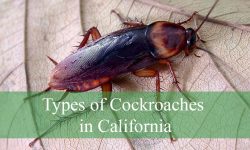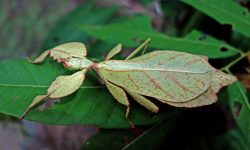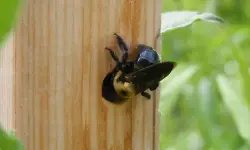Black aphids are tiny insects that can cause big problems for gardeners and farmers alike. These sap-sucking pests often gather in large groups on the leaves, stems, and buds of many plants. Their feeding weakens plants, causing leaf curling, stunted growth, and sometimes the spread of harmful plant diseases through the sticky honeydew they produce.
There are many different types of black aphids, each with unique features and preferred host plants. From the common Black Bean Aphid to the less familiar Giant Willow Aphid, knowing how to identify these pests is the first step in controlling them. This article provides clear descriptions and pictures of 18 common black aphid species to help with accurate identification.
Understanding the various species of black aphids is crucial for effective pest management. Early recognition can prevent infestations from becoming severe and protect plants from long-term damage. This guide will help you learn how to spot, identify, and manage black aphids successfully.
Different Types of Black Aphids and How to Get Rid of Them
Black Bean Aphid (Aphis fabae)

The Black Bean Aphid is a small, dark-colored insect that often appears in dense colonies on the tender shoots of plants. It measures about 1.5 to 3 mm in length and has a soft, pear-shaped body. This aphid is typically shiny black or dark green and may be winged or wingless depending on environmental conditions.
This species commonly infests beans, sugar beets, and ornamental plants. It feeds on plant sap, causing leaf curling, yellowing, and reduced growth. It also excretes honeydew, which promotes the growth of sooty mold and attracts ants. The Black Bean Aphid can act as a vector for plant viruses, making its presence particularly harmful in agricultural settings.
To control Black Bean Aphids, gardeners can introduce natural predators like ladybugs and lacewings. Regularly washing plants with water can dislodge colonies, and neem oil or insecticidal soap sprays are also effective. Crop rotation and the removal of infested plant debris help reduce recurring outbreaks.
Cherry Blackfly (Myzus cerasi)
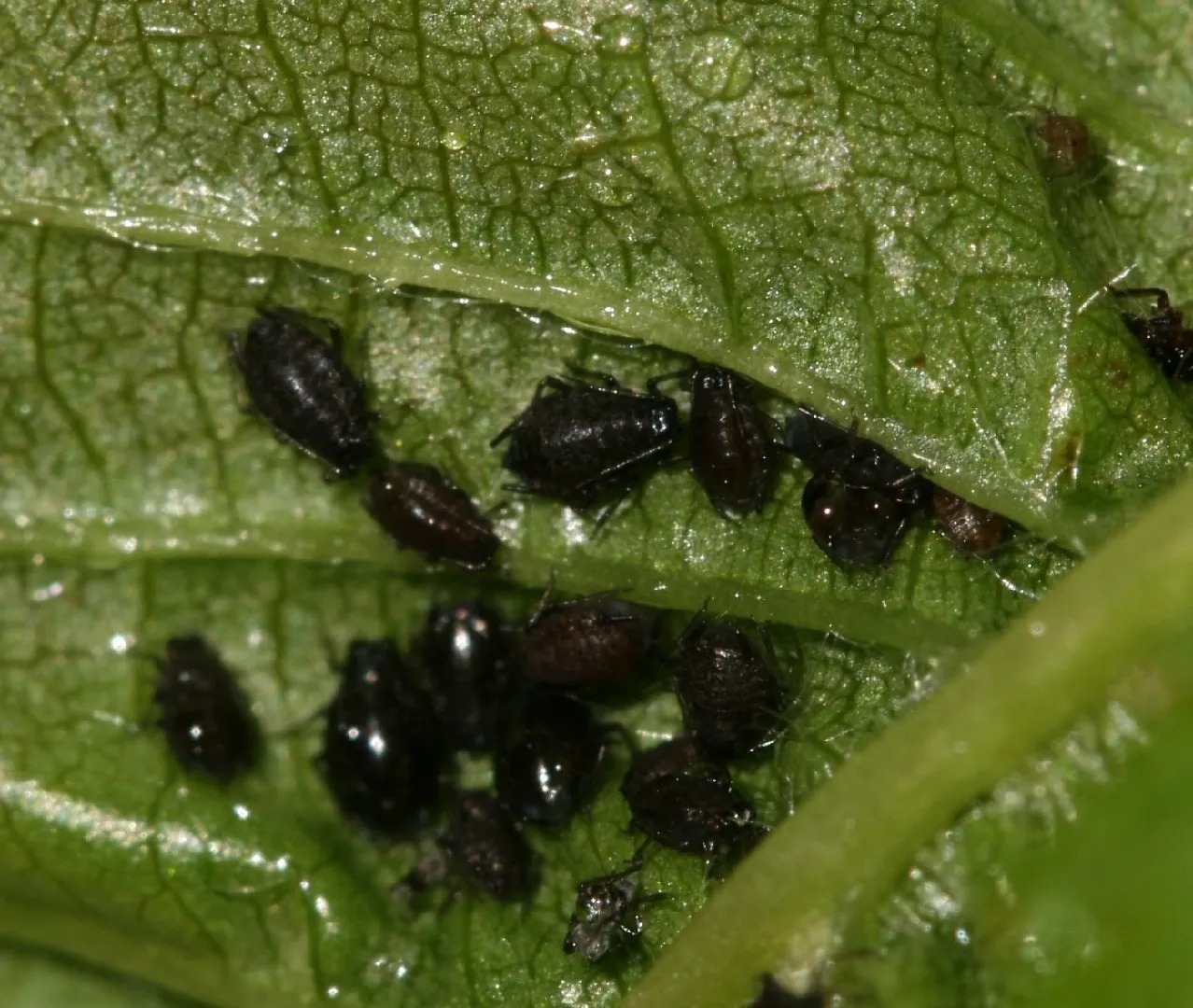
The Cherry Blackfly is a shiny black aphid species that targets cherry trees, especially sweet and sour varieties. Adults are small, typically under 2.5 mm, and may develop wings during later stages of colony development. They are most active during spring when cherry trees begin to leaf out.
These aphids feed by sucking sap from young leaves and shoots, causing the foliage to curl, twist, and eventually stunt the plant’s growth. This can severely reduce fruit production if infestations are left unmanaged. Their secreted honeydew also attracts ants and fosters sooty mold, which interferes with photosynthesis.
Effective control includes pruning infested shoots and applying insecticidal soaps early in the season. Introducing parasitoid wasps such as Aphidius matricariae helps suppress populations. Horticultural oils and neem oil can also be used before the aphids become too numerous.
Black Citrus Aphid (Toxoptera aurantii)

The Black Citrus Aphid is a small, dark insect commonly found on citrus trees, including oranges, lemons, and grapefruits. It has a distinctive glossy black body and can reproduce rapidly in warm, humid conditions. Adults are typically wingless, but winged forms appear when colonies grow too large.
This aphid species feeds on the sap of young citrus leaves and shoots, resulting in leaf curling, distortion, and reduced vigor. It is also known to transmit plant viruses such as Citrus tristeza virus. The sticky honeydew they produce encourages the growth of black sooty mold, further weakening the plant.
Management strategies include encouraging beneficial insects like ladybugs and syrphid flies. Spraying horticultural oil or insecticidal soap on affected areas can control small outbreaks. Regular pruning of infested parts and keeping trees well-ventilated helps prevent large infestations.
Black Peach Aphid (Brachycaudus persicae)
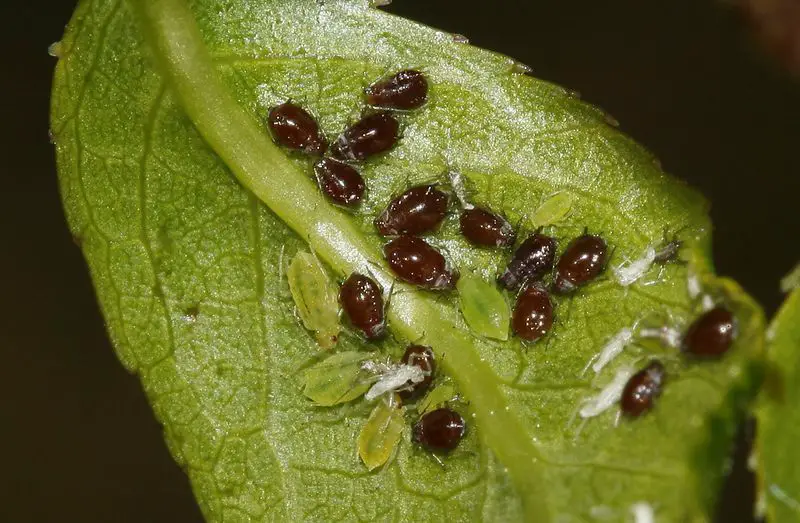
The Black Peach Aphid is a dark-colored aphid that attacks peach trees and other members of the stone fruit family, including plums and apricots. It is often found clustered on the undersides of leaves and young shoots. Adults are small, with a glossy black appearance, and may be winged or wingless.
These aphids feed on plant sap, which results in leaf curling, shoot deformation, and overall poor tree vigor. They are capable of transmitting several plant viruses, making them a significant threat in orchards. Infested trees may show reduced fruit quality and quantity over time.
Integrated pest management approaches include introducing predatory insects like lacewings or parasitic wasps. Chemical controls such as neem oil or pyrethrin-based insecticides can be used during the early stages of infestation. Regular monitoring and removal of heavily infested leaves are also recommended.
Woolly Alder Aphid (Paraprociphilus tessellatus)

The Woolly Alder Aphid is easily recognized by its unusual appearance—its dark body is covered in white, waxy filaments that give it a cottony look. It grows up to 3 mm long and is mostly found on alder trees during late summer and autumn. In spring, it migrates to silver maple trees to complete its life cycle.
This species feeds on sap from leaves and branches, which may cause minor leaf distortion and growth issues in young trees. While generally not a major pest, large populations can create unsightly accumulations of wax and honeydew. These conditions may also attract ants and support mold growth.
Control is usually not necessary for healthy trees, as natural predators such as hoverflies and lady beetles keep populations in check. In cases of heavy infestation, pruning and disposing of affected branches can help. Avoiding over-fertilization reduces the likelihood of encouraging aphid outbreaks.
Melon Aphid / Cotton Aphid (Aphis gossypii)
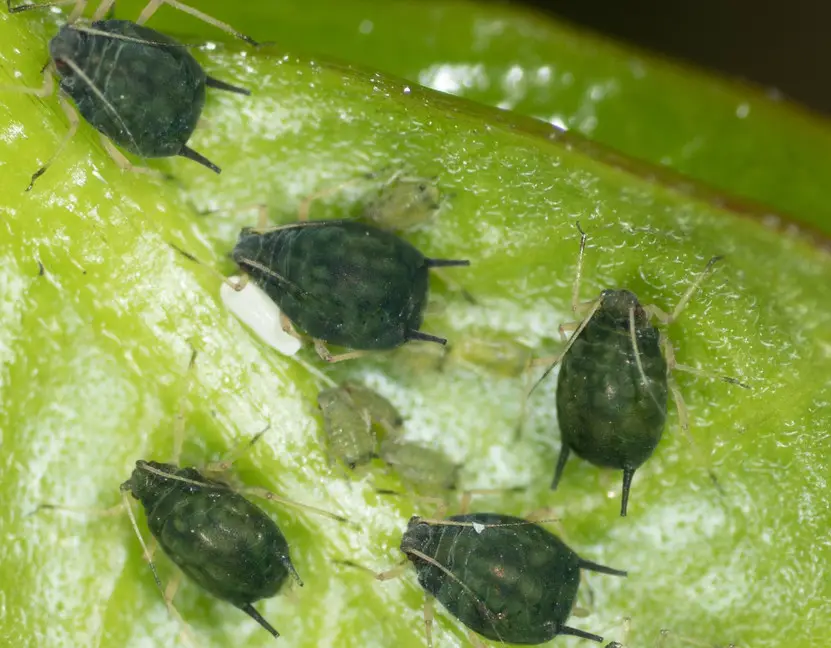
The Melon Aphid, also known as the Cotton Aphid, is a small sap-sucking insect that can vary in color from pale yellow-green to dark green or nearly black. Adult aphids measure between 1 to 2 mm in length and are soft-bodied, pear-shaped insects that reproduce rapidly through parthenogenesis, especially in warm climates.
This aphid species infests a wide range of host plants, including watermelon, cucumber, pumpkin, zucchini, and cotton. It typically colonizes the undersides of leaves and the tender growing points of plants. Heavy infestations lead to leaf curling, stunted growth, and honeydew buildup, which attracts ants and fosters sooty mold.
Management includes encouraging beneficial predators like ladybugs and lacewings and applying insecticidal soaps or neem oil to infested areas. Reducing nitrogen fertilizer use can help slow aphid population growth. In severe outbreaks, systemic insecticides may be necessary for commercial crops.
Cowpea Aphid / Black Legume Aphid (Aphis craccivora)

The Cowpea Aphid, also known as the Black Legume Aphid, is a shiny black insect with pale yellow legs and antennae. It is usually around 1.5 to 2 mm in length and can appear in large, clustered groups on host plants. Some individuals may develop wings to help spread the colony to new plants.
This species is a common pest on leguminous crops such as cowpeas, soybeans, peanuts, lentils, and alfalfa. It feeds on sap from tender shoots and flower buds, causing deformation, yellowing, and stunting. It also transmits viral diseases like cowpea aphid-borne mosaic virus, making it a serious concern in tropical agriculture.
To control Cowpea Aphids, farmers can use reflective mulches to deter colonization, introduce parasitic wasps like Aphidius colemani, or apply neem-based sprays. Crop rotation and removal of plant debris help prevent reinfestation. Early detection and intervention are crucial to limit virus spread.
Giant Willow Aphid (Tuberolachnus salignus)

The Giant Willow Aphid is the largest aphid species, with adult females growing up to 5 mm long. These aphids are dark brown to black and have a robust, oval-shaped body. They often cluster in massive colonies on the trunks and branches of willows, especially during late summer and fall.
This aphid is specific to willow trees and is mostly found in temperate regions across Europe, Asia, and North America. Although it does not usually kill the tree, it can cause significant stress by draining large amounts of sap and producing excessive honeydew. This sticky substance coats leaves and surfaces, encouraging mold growth and attracting nuisance insects.
Control is usually unnecessary on mature trees, but high populations can be reduced by pruning heavily infested limbs. Natural predators such as birds and predatory insects may help manage numbers. For smaller ornamental willows, horticultural oils or insecticidal soaps can be used as needed.
Giant Bark Aphid (Longistigma caryae)
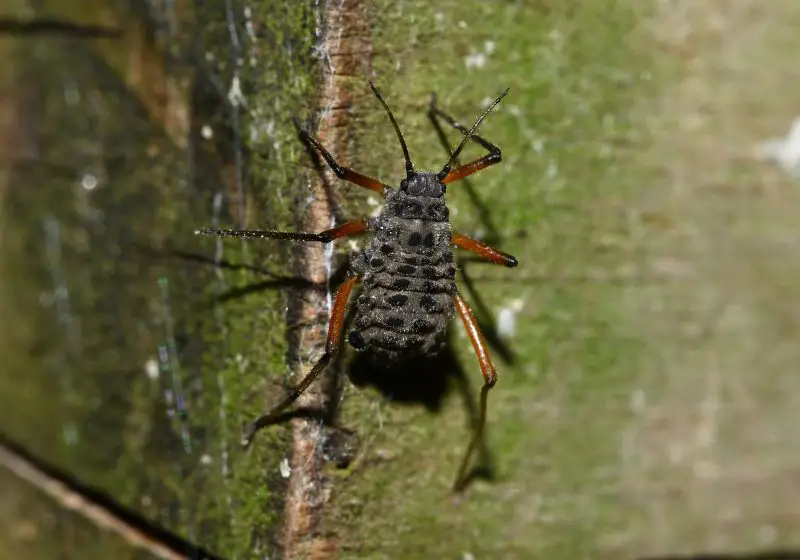
The Giant Bark Aphid is one of the largest aphid species in North America, with adults reaching up to 6 mm in length. It has a long, slender body that is dark gray to black, often covered with small white spots. This species typically forms dense colonies on tree bark.
It commonly infests hickory, pecan, and oak trees, feeding on sap from twigs and branches. Though not usually lethal to healthy trees, large infestations can cause twig dieback and copious amounts of honeydew, leading to sooty mold development. These aphids are most visible during the spring and early summer.
To manage Giant Bark Aphids, natural enemies like syrphid flies and lady beetles are effective. If needed, pruning affected areas and spraying with horticultural oil or insecticidal soap may reduce their numbers. Ensuring trees are well-watered and not stressed will also help reduce vulnerability.
Poplar Aphid (Chaitophorus populicola)

The Poplar Aphid is a small, dark-bodied insect often covered in a white waxy coating that gives it a dusty appearance. Adults measure about 2 mm and may be winged or wingless depending on the stage of colony development. They are typically found on poplar trees, especially in temperate regions.
This species feeds on the underside of young poplar leaves, causing them to curl and deform. Infestations can reduce photosynthesis, inhibit growth, and leave trees looking unsightly. The honeydew they secrete also leads to sooty mold buildup and attracts ants, which can interfere with natural predators.
Control measures include spraying with neem oil or insecticidal soap, particularly in ornamental settings where appearance matters. Encouraging natural predators and regularly inspecting young trees during spring and early summer can help catch infestations early. Removing infested leaves may also be useful in localized outbreaks.
Corn Leaf Aphid / Hedgehog Grain Aphid (Sipha maydis)
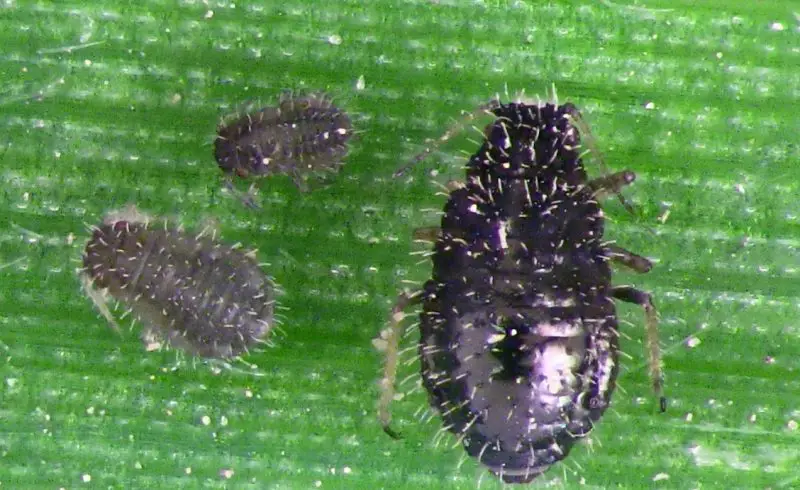
The Corn Leaf Aphid, also known as the Hedgehog Grain Aphid, is a small, dark-colored insect typically found on cereal crops. Its body is black to dark green with a spiny appearance due to small bristle-like projections, giving it a unique texture compared to other aphids. Adults are about 1.5 to 2 mm in size and often appear in clusters.
This aphid species feeds on a wide range of grasses and cereal crops, including wheat, barley, oats, and corn. It prefers the whorls of young plants and leaf sheaths, where it can suck sap and reduce plant vigor. Heavy infestations can cause leaf curling, yellowing, and a decline in yield, especially in drought-stressed fields.
To manage Corn Leaf Aphids, early detection is crucial. Promoting natural enemies like lady beetles and hoverflies helps maintain balance. Insecticidal soaps or selective insecticides may be applied if infestations threaten crop productivity. Managing weeds and avoiding excessive nitrogen fertilization can also reduce their spread.
Water Lily Aphid (Rhopalosiphum nymphaeae)
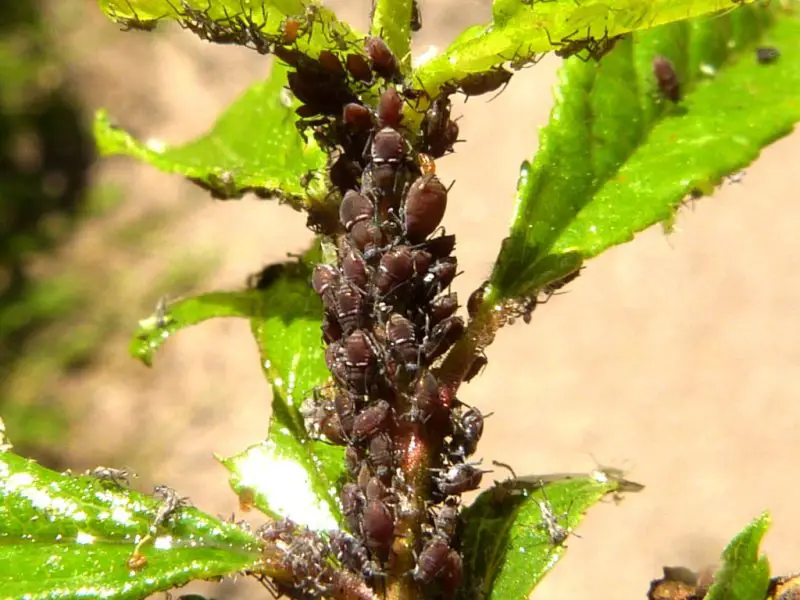
The Water Lily Aphid is a small aphid species that is dark brown to black and often covered with a slight waxy bloom. Adults are wingless or winged and measure around 1.2 to 2 mm in length. They typically inhabit the undersides of floating leaves on aquatic plants, making them harder to notice until populations are high.
This species primarily feeds on aquatic plants such as water lilies, lotus, and other floating vegetation. It pierces leaf tissues and sucks plant sap, leading to mottled or yellowed leaves. Infestations can reduce the aesthetic appeal and health of ornamental pond plants.
Controlling Water Lily Aphids can be challenging due to their aquatic habitat. Manual removal with a water spray or wiping leaves can be effective in small ponds. Introducing aquatic-safe insecticidal soap or encouraging natural predators like water beetles and aquatic insects can help keep populations in check.
Elder Aphid (Aphis sambuci)

The Elder Aphid is a dark-colored aphid, usually black or deep green, with a glossy body and short antennae. Adults grow up to 2.5 mm long and form dense colonies on elder plants. These aphids reproduce rapidly and are often seen during the spring and summer months.
This species is primarily associated with elder trees and shrubs but may occasionally be found on other woody plants. It feeds on the sap of young shoots, leaves, and stems, causing curling, yellowing, and wilting. The large amounts of honeydew they secrete attract ants and promote sooty mold development.
To manage Elder Aphids, pruning infested shoots and encouraging beneficial insects like lacewings and parasitic wasps can be effective. In ornamental settings, applying neem oil or insecticidal soap may reduce their numbers. Regular monitoring helps catch infestations before they become severe.
Thistle Aphid / Plum-Cardoon Aphid (Brachycaudus cardui)
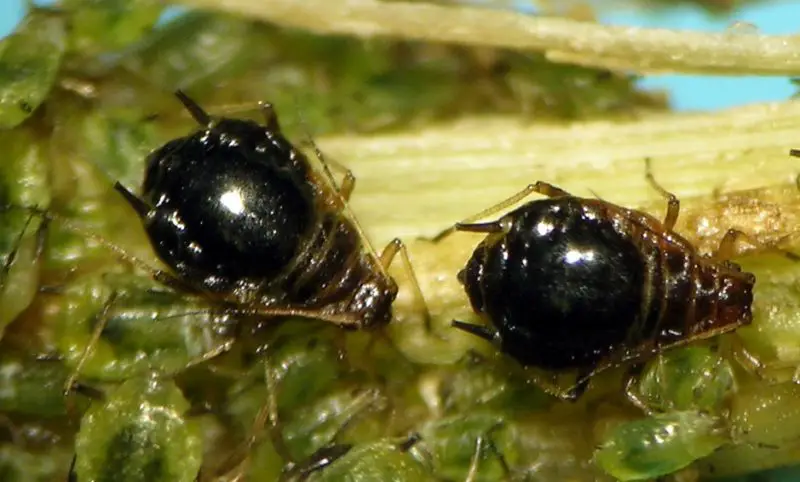
The Thistle Aphid, also known as the Plum-Cardoon Aphid, is a small, dark-colored aphid that measures around 2 mm long. It has a dark brown to black body with short siphunculi and a relatively flat appearance. This species is often seen on the undersides of leaves in tight colonies.
It commonly infests plum trees, artichokes, and thistle plants. The aphid sucks plant sap, which leads to curling, stunted growth, and sometimes gall formation on stems. It is also capable of transmitting plant viruses that affect fruit production and quality in plums.
Effective management includes removing nearby weedy hosts like thistles that support the aphid’s lifecycle. Introducing natural predators or applying insecticidal soap early in the season can help. In fruit orchards, systemic insecticides may be needed if aphids pose a significant threat to yield.
Black and Orange Aphid (Uroleucon rudbeckiae)

The Black and Orange Aphid is easily recognized by its striking coloration, featuring a shiny black body and a dark orange or reddish abdomen. Adults can reach up to 2.5 mm in length and have long legs and antennae, giving them a distinct silhouette on plant surfaces.
This aphid specializes in plants from the aster family, particularly sunflowers, coneflowers, and black-eyed Susans. It typically colonizes flower stems and the undersides of leaves, feeding on sap and weakening the plant. Infestations may lead to reduced flowering, distorted growth, and honeydew buildup.
Control methods include washing aphids off with water or applying neem oil to ornamental plants. Supporting beneficial insects such as ladybugs and syrphid fly larvae can naturally reduce populations. Removing heavily infested plant parts helps prevent further spread in garden beds.
Onion Aphid (Neotoxoptera formosana)

The Onion Aphid is a small aphid species with a dark brown to reddish-black body. Adults are usually 1.5 to 2 mm long and form dense colonies at the base of onion leaves and flower stalks. Their coloration and waxy coating give them a shiny, almost metallic appearance when viewed closely.
This species attacks members of the Allium family, including onions, garlic, and leeks. They feed by piercing plant tissues and sucking out sap, leading to stunted growth, curled leaves, and delayed bulb development. They are also known vectors of viral diseases that can devastate commercial crops.
To control Onion Aphids, early detection and quick action are crucial. Removing plant debris, avoiding overhead irrigation, and rotating crops can reduce infestations. Insecticidal soap, neem oil, or selective aphidicides may be used for severe cases, especially in commercial settings.
Banana Aphid (Pentalonia nigronervosa)
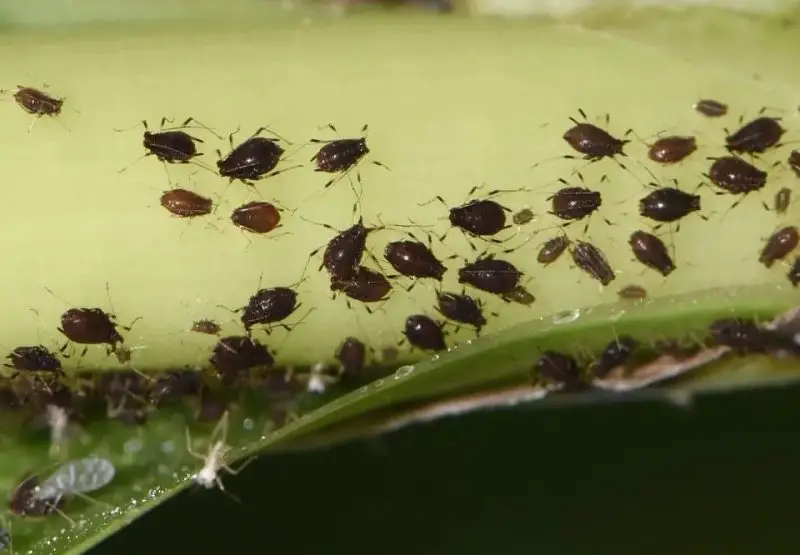
The Banana Aphid is a small, dark brown to black aphid with reddish undertones and a smooth, rounded body. Measuring 1.2 to 2 mm in length, it typically forms colonies on the undersides of banana leaves, at the leaf axils, and around the base of young suckers.
This aphid species is a serious pest of banana plants, not just because of its feeding habits but also due to its role in transmitting Banana Bunchy Top Virus (BBTV), one of the most destructive diseases in banana cultivation. Infested plants often show stunted growth, leaf chlorosis, and tight clustering of foliage.
Effective control involves removing infected plants to reduce virus spread. Encouraging natural predators and applying horticultural oils or systemic insecticides can suppress populations. In commercial plantations, integrated pest management (IPM) programs are essential to prevent BBTV outbreaks.
Oleander Aphid (Aphis nerii)
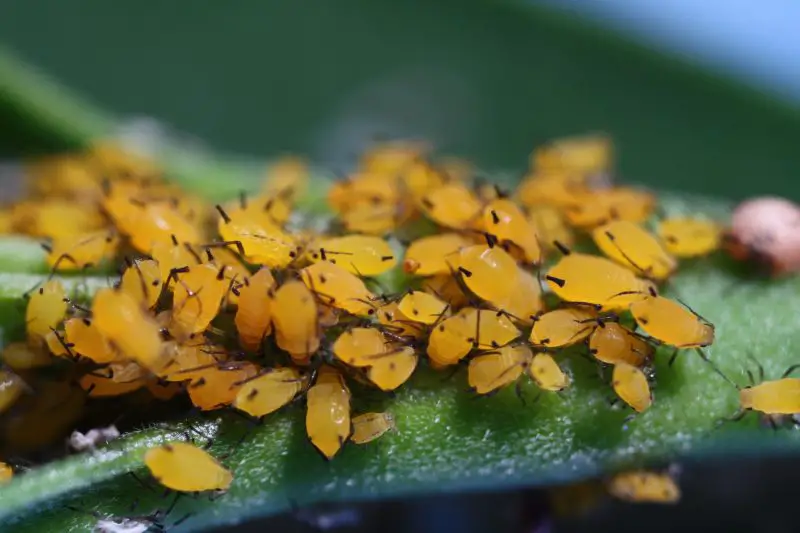
The Oleander Aphid is commonly recognized by its bright yellow color, but in rare instances, individuals may appear dark brown or nearly black, particularly in extreme environmental conditions. These aphids have a soft body and black legs, antennae, and cornicles, making even the yellow forms easy to identify.
They mainly infest oleander and milkweed plants, clustering on new shoots and flower buds. While their feeding doesn’t always kill the plant, it can cause distorted growth and reduce blooming. They also secrete sticky honeydew, which attracts ants and fosters sooty mold.
Management typically focuses on encouraging beneficial insects like ladybugs and lacewings. Hand removal or pruning heavily infested sections can help. Since Aphis nerii doesn’t usually damage plants severely, chemical control is rarely needed except in ornamental displays or butterfly gardens.

